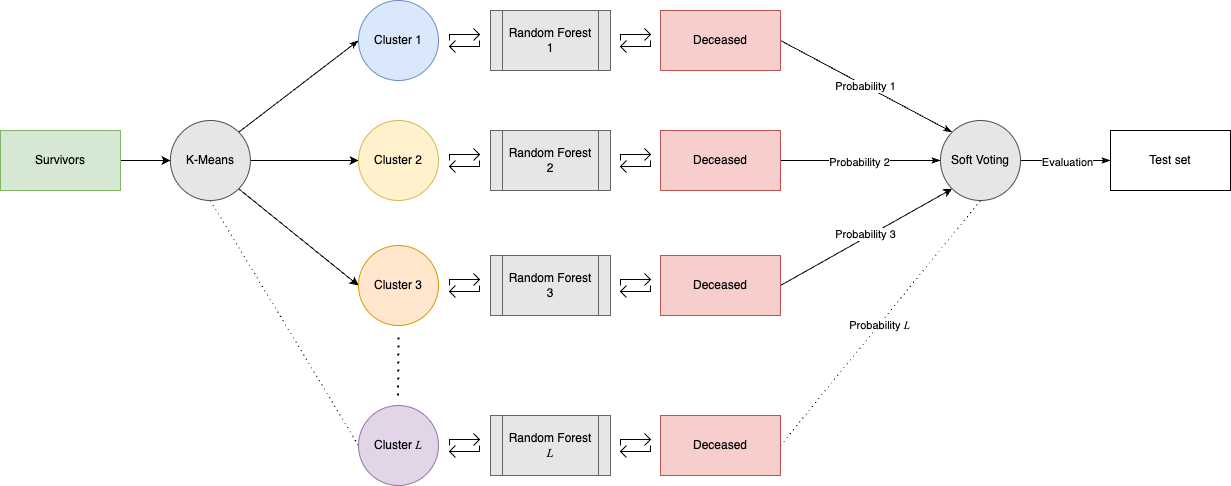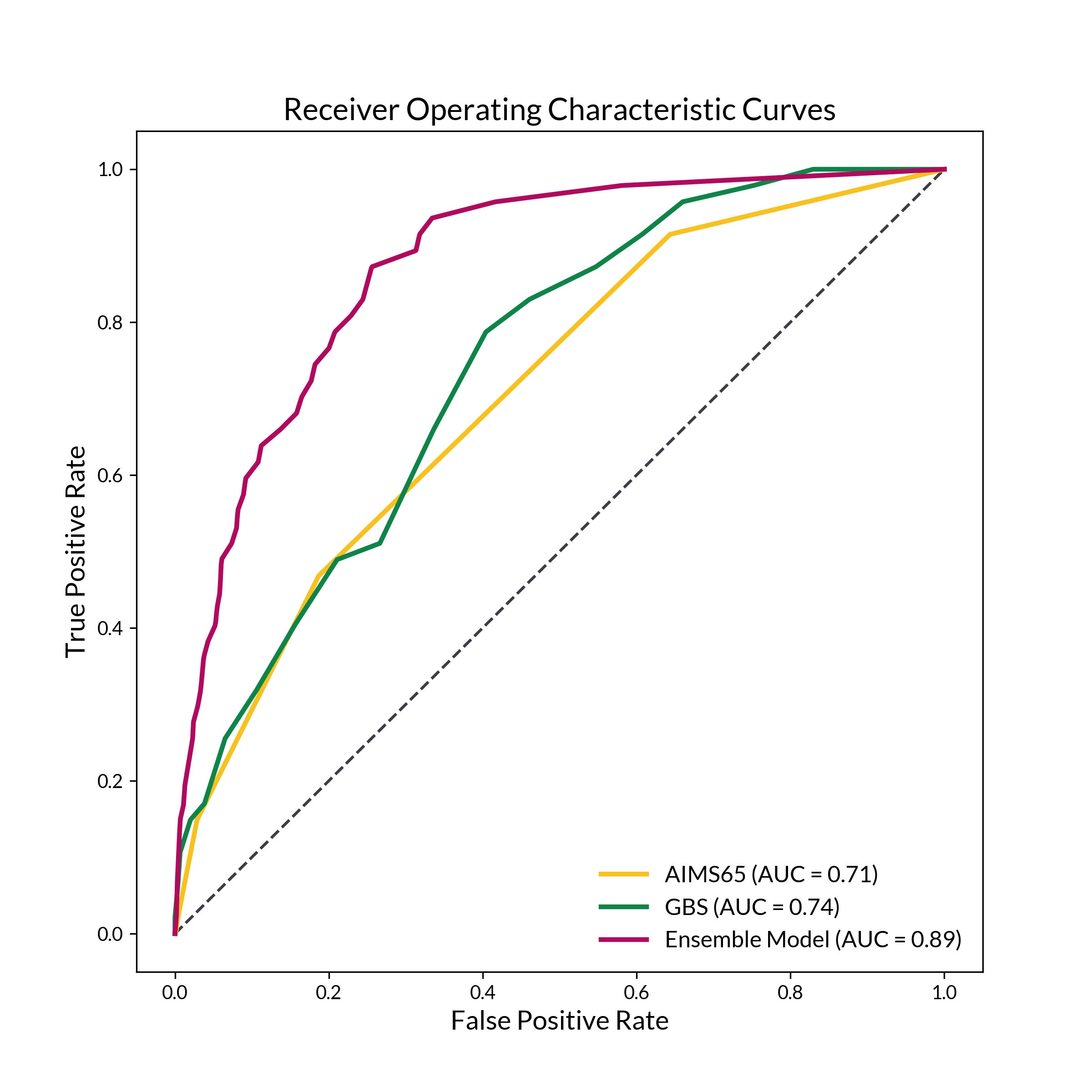Tuesday Poster Session
Category: GI Bleeding
P5197 - A Clustering-Based Machine Learning Approach for Mortality Prediction in Gastrointestinal Bleeding
Tuesday, October 28, 2025
10:30 AM - 4:00 PM PDT
Location: Exhibit Hall
- LA
Laith Alomari, MD
Thomas Jefferson University
Philadelphia, PA
Presenting Author(s)
Award: ACG Presidential Poster Award
Laith Alomari, MD1, Zaid Al-Fakhouri, MD2, Jaber Jaradat, MS3, Tinsae Anebo, MD4, Justin Lam, MD1, Emmanuel Otabor, MBBS1, Daniel M. Simadibrata, MD2, Thai Hau Koo, MD5, Fnu Deepali, MD1, Jana Alomari, MS6, Ghideon Ezaz, MD1
1Thomas Jefferson University, Philadelphia, PA; 2Case Western Reserve University / MetroHealth, Cleveland, OH; 3Faculty of Medicine, Mutah University, Al-Karak, Al Karak, Jordan; 4Jefferson Einstein Hospital/Thomas Jefferson University, Philadelphia, PA; 5University of Sciences Malaysia Specialist Hospital, Kelantan, Kelantan, Malaysia; 6Jordan University of Science and Technology, Irbid, Irbid, Jordan
Introduction: Gastrointestinal (GI) bleeding is a common, life‐threatening emergency with considerable morbidity and mortality. Traditional risk scores like AIMS65 and Glasgow-Blatchford Score (GBS) are limited in capturing non-linear clinical interactions. This study aimed to develop and validate a machine learning (ML) model employing a clustering-based ensemble approach to predict 30-day mortality in GI bleeding patients and to compare its performance with established risk scores.
Methods: We retrospectively analyzed data from the MIMIC-IV-ED database, identifying 5,453 ED patients with GI bleeding (236 deaths; 4.32%) within 30 days. Sixteen clinical and laboratory variables were selected. The cohort was divided into training (80%) and test (20%) sets. Survivors were partitioned into 24 clusters using K-Means, and separate Random Forest models were trained on each cluster combined with all deceased cases. Overall performance was evaluated using the area under the receiver operating characteristic curve (AUC), sensitivity, and specificity across different thresholds.
Results: The model achieved an AUC of 0.88 (95% CI: 0.86–0.90), significantly outperforming AIMS65 (0.71, 95% CI: 0.60–0.82) and GBS (0.74, 95% CI: 0.64–0.85) (p< 0.0001). At optimal thresholds, the model achieved a sensitivity of 86.8% and specificity of 74.6%. At maximal sensitivity thresholds (ranging between 90-100%), the model maintained a higher specificity (56.1%) than AIMS65 (35.6%) and GBS (17.1%). SHAP analysis identified age, hemodynamic instability, coagulopathy, and comorbidities as key predictors.
Discussion: Our clustering-based ensemble ML model provides a simple and superior risk stratification for 30-day mortality in GI bleeding compared to conventional scores, offering promising potential for real-time clinical integration.

Figure: Schematic overview of the ensemble prediction methodology for mortality risk assessment in GI bleeding patients. The majority class (survivors) is partitioned into L (in our case, L = 24) clusters via K-means clustering, with each cluster subset combined with the minority class (deceased) to train and fine-tune individual Random Forest models. Probabilistic predictions from all L models are aggregated through soft voting, and the ensemble output is evaluated on the test set to generate final mortality risk predictions.

Figure: Receiver operating characteristic (ROC) curves comparing the ensemble model, AIMS65 (cutoff ≥2), and Glasgow-Blatchford Score (GBS, cutoff ≥1). The ensemble model demonstrated superior discrimination with an AUC of 0.89, compared to 0.71 for AIMS65 and 0.74 for GBS. The dashed diagonal line represents a random classifier.
Disclosures:
Laith Alomari indicated no relevant financial relationships.
Zaid Al-Fakhouri indicated no relevant financial relationships.
Jaber Jaradat indicated no relevant financial relationships.
Tinsae Anebo indicated no relevant financial relationships.
Justin Lam indicated no relevant financial relationships.
Emmanuel Otabor indicated no relevant financial relationships.
Daniel Simadibrata indicated no relevant financial relationships.
Thai Hau Koo indicated no relevant financial relationships.
Fnu Deepali indicated no relevant financial relationships.
Jana Alomari indicated no relevant financial relationships.
Ghideon Ezaz indicated no relevant financial relationships.
Laith Alomari, MD1, Zaid Al-Fakhouri, MD2, Jaber Jaradat, MS3, Tinsae Anebo, MD4, Justin Lam, MD1, Emmanuel Otabor, MBBS1, Daniel M. Simadibrata, MD2, Thai Hau Koo, MD5, Fnu Deepali, MD1, Jana Alomari, MS6, Ghideon Ezaz, MD1. P5197 - A Clustering-Based Machine Learning Approach for Mortality Prediction in Gastrointestinal Bleeding, ACG 2025 Annual Scientific Meeting Abstracts. Phoenix, AZ: American College of Gastroenterology.
Laith Alomari, MD1, Zaid Al-Fakhouri, MD2, Jaber Jaradat, MS3, Tinsae Anebo, MD4, Justin Lam, MD1, Emmanuel Otabor, MBBS1, Daniel M. Simadibrata, MD2, Thai Hau Koo, MD5, Fnu Deepali, MD1, Jana Alomari, MS6, Ghideon Ezaz, MD1
1Thomas Jefferson University, Philadelphia, PA; 2Case Western Reserve University / MetroHealth, Cleveland, OH; 3Faculty of Medicine, Mutah University, Al-Karak, Al Karak, Jordan; 4Jefferson Einstein Hospital/Thomas Jefferson University, Philadelphia, PA; 5University of Sciences Malaysia Specialist Hospital, Kelantan, Kelantan, Malaysia; 6Jordan University of Science and Technology, Irbid, Irbid, Jordan
Introduction: Gastrointestinal (GI) bleeding is a common, life‐threatening emergency with considerable morbidity and mortality. Traditional risk scores like AIMS65 and Glasgow-Blatchford Score (GBS) are limited in capturing non-linear clinical interactions. This study aimed to develop and validate a machine learning (ML) model employing a clustering-based ensemble approach to predict 30-day mortality in GI bleeding patients and to compare its performance with established risk scores.
Methods: We retrospectively analyzed data from the MIMIC-IV-ED database, identifying 5,453 ED patients with GI bleeding (236 deaths; 4.32%) within 30 days. Sixteen clinical and laboratory variables were selected. The cohort was divided into training (80%) and test (20%) sets. Survivors were partitioned into 24 clusters using K-Means, and separate Random Forest models were trained on each cluster combined with all deceased cases. Overall performance was evaluated using the area under the receiver operating characteristic curve (AUC), sensitivity, and specificity across different thresholds.
Results: The model achieved an AUC of 0.88 (95% CI: 0.86–0.90), significantly outperforming AIMS65 (0.71, 95% CI: 0.60–0.82) and GBS (0.74, 95% CI: 0.64–0.85) (p< 0.0001). At optimal thresholds, the model achieved a sensitivity of 86.8% and specificity of 74.6%. At maximal sensitivity thresholds (ranging between 90-100%), the model maintained a higher specificity (56.1%) than AIMS65 (35.6%) and GBS (17.1%). SHAP analysis identified age, hemodynamic instability, coagulopathy, and comorbidities as key predictors.
Discussion: Our clustering-based ensemble ML model provides a simple and superior risk stratification for 30-day mortality in GI bleeding compared to conventional scores, offering promising potential for real-time clinical integration.

Figure: Schematic overview of the ensemble prediction methodology for mortality risk assessment in GI bleeding patients. The majority class (survivors) is partitioned into L (in our case, L = 24) clusters via K-means clustering, with each cluster subset combined with the minority class (deceased) to train and fine-tune individual Random Forest models. Probabilistic predictions from all L models are aggregated through soft voting, and the ensemble output is evaluated on the test set to generate final mortality risk predictions.

Figure: Receiver operating characteristic (ROC) curves comparing the ensemble model, AIMS65 (cutoff ≥2), and Glasgow-Blatchford Score (GBS, cutoff ≥1). The ensemble model demonstrated superior discrimination with an AUC of 0.89, compared to 0.71 for AIMS65 and 0.74 for GBS. The dashed diagonal line represents a random classifier.
Disclosures:
Laith Alomari indicated no relevant financial relationships.
Zaid Al-Fakhouri indicated no relevant financial relationships.
Jaber Jaradat indicated no relevant financial relationships.
Tinsae Anebo indicated no relevant financial relationships.
Justin Lam indicated no relevant financial relationships.
Emmanuel Otabor indicated no relevant financial relationships.
Daniel Simadibrata indicated no relevant financial relationships.
Thai Hau Koo indicated no relevant financial relationships.
Fnu Deepali indicated no relevant financial relationships.
Jana Alomari indicated no relevant financial relationships.
Ghideon Ezaz indicated no relevant financial relationships.
Laith Alomari, MD1, Zaid Al-Fakhouri, MD2, Jaber Jaradat, MS3, Tinsae Anebo, MD4, Justin Lam, MD1, Emmanuel Otabor, MBBS1, Daniel M. Simadibrata, MD2, Thai Hau Koo, MD5, Fnu Deepali, MD1, Jana Alomari, MS6, Ghideon Ezaz, MD1. P5197 - A Clustering-Based Machine Learning Approach for Mortality Prediction in Gastrointestinal Bleeding, ACG 2025 Annual Scientific Meeting Abstracts. Phoenix, AZ: American College of Gastroenterology.

